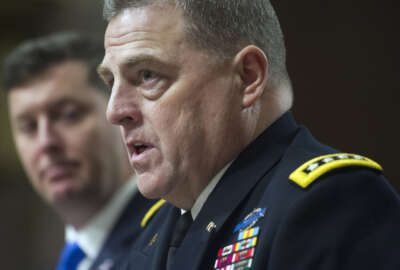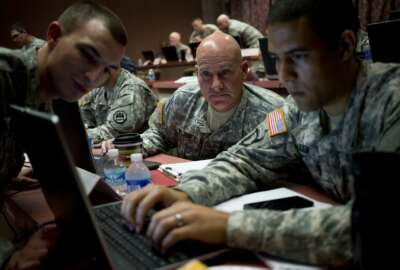
Army kicks off largest reorganization of acquisition bureaucracy since Vietnam
The Army has launched a four-month project to create a new "modernization command," and plans to have it fully functional by next summer.
Subscribe to Federal Drive’s daily audio interviews on iTunes or PodcastOne
Senior Army leaders said Monday they’re pushing toward what’s likely to wind up as the service’s largest organizational shake-up in 40 years: standing up a brand-new command to centralize many of the bureaucratic tasks required to buy new equipment.
The motivation: the Army has too many organizations that own some small piece of the Defense Department’s famously complex acquisition process, officials say, making all of the procedures that happen between the time a need is identified and the point at which the service buys a solution more complicated than necessary, and more to the point, too slow.
In creating a new “modernization command,” officials say they want soldiers to be involved in the acquisition process from beginning to end, the theory being that previous efforts have asked for feedback from end users far too late in the acquisition process, prompting changes that are difficult and expensive to make once a system has progressed too far into its development lifecycle.
“With a few exceptions, what we have is essentially a linear process — going from an idea, writing up a big requirements document and then vetting it through multiple steps — it takes years, and it’s just not going to be effective going into the future,” Gen. Mark Milley, the Army’s chief of staff, told reporters. “So we’re going to re-engineer the corporation.”
Almost everything about what the newly-engineered corporation will look like is firmly in the “to be determined” category, but the Army’s senior leaders are planning a fairly aggressive schedule.
Starting this week, Lt. Gen. Edward Cardon, the director of the Office of Business Transformation, will convene a task force to look at the current Army modernization bureaucracy and return with final recommendations on how to structure the new modernization command. The recommendations are due four months from now, and the new command is supposed to be up and running by next summer.
At the end of the process, the Army wants to have all of the organizations that currently have a hand in developing and fielding new capabilities under “one roof,” said Ryan McCarthy, the acting secretary of the Army.
“We want to enable rapid prototyping, accept failure early, insert the end-user early in the process and keep them engaged throughout,” he said.
The changes are most likely to affect the current acquisition roles performed by Army Materiel Command, Army Forces Command and Army Training Doctrine Command, some of the largest organizations that currently have a large hand in defining the Army’s requirements and managing their sustainment costs long after acquisition decisions have been made.
“We look at this as a restructuring, not creating something new,” McCarthy said. “It’s merging roles and responsibilities together in the way you’d merge companies, or divisions within a company. When the economy changes, a company divests capabilities it doesn’t need, it merges to get economies of scale to fuse people and information so that it moves faster. We haven’t done that in 40 years. We haven’t even looked at it. What we’ve done periodically is put pieces in place: we created the Army Research and Development Command, we created the Army Capabilities Integration Center and other things. We’ve upgraded the pieces, but fusing them together to make the system go faster is our goal in this particular case.”
Whatever Cardon’s task force decides, it will not do much to change the chain of command for the Army’s senior civilian acquisition leadership: program managers and program executive officers will still report to the service’s assistant secretary for acquisition, logistics and technology; that person will still be the Army’s gatekeeper that controls when programs are allowed to move beyond major milestones, a circumstance that’s mandated by law.
Latest Army News
Although McCarthy deferred most questions about what the new modernization command will actually do until Cardon’s team completes its work, he said it would need to incorporate new “cross-functional teams” that focus on the Army’s top six modernization priorities: long-range precision weapons, a next-generation combat vehicle, future vertical lift platforms, missile defense, and a better-protected and more mobile tactical network.
The push for a new command builds off of two directives McCarthy signed within a few weeks of being confirmed as undersecretary of the Army, and Milley said some of the initiatives had been underway for several months before that.
One ordered the acquisition community to begin to develop new procedures to shave two years off of the requirements development process, which currently takes between three and five years, and to create pilot versions of the cross-functional teams the Army wants to use in the new command.
A second was focused on improving talent management within the Army’s acquisition community.
“We want our people to have an appropriate set of experiences,” he said. “We want our program managers and officers to have fellowships with industry, masters degrees within certain disciplines. It’s also about the tenures for people in program management. We’re looking at tours of three-to-four years, so more continuity and the right set of experiences so that they have a broader perspective than the ones we’ve had previously.”
Return to the DoD Reporter’s Notebook
Copyright © 2025 Federal News Network. All rights reserved. This website is not intended for users located within the European Economic Area.
Jared Serbu is deputy editor of Federal News Network and reports on the Defense Department’s contracting, legislative, workforce and IT issues.
Follow @jserbuWFED





